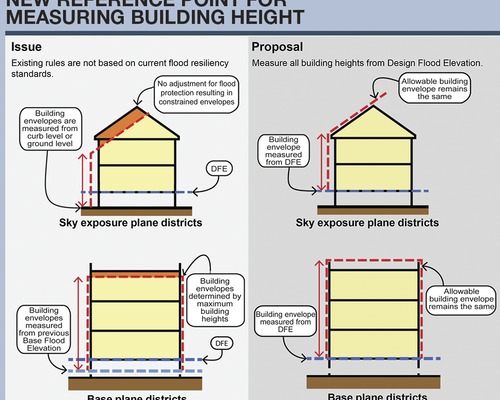Now that proposed Superstorm Sandy-triggered changes to New York City zoning are out for public review, building owners, designers and contractors are eagerly awaiting the second piece of the post-Sandy regulation puzzle: proposed modifications to the city's building code. The adjustments to the two sets of regulations should go a long way toward aiding the design and construction of buildings that are safer and more resilient when exposed to floods and other major climate-related events, says Robert D. LiMandri, New York City's commissioner of buildings.

After the storm, the city increased the flood elevation standards required under the building code by including an additional 1 or 2 ft of required elevation, known as "freeboard." Owners of buildings severely damaged or destroyed by last October's storm are required to comply with the flood-resistant construction standards of the building code when they rebuild.
In many instances, conflicts between zoning and building-code requirements would make it difficult or, in some cases, impossible for owners to build or retrofit to the standards, says the Dept. of City Planning (DCP). The proposed zoning changes are designed to eliminate the conflicts. They are also written to enable new and existing buildings throughout designated flood zones to meet the latest federal standards for flood-resistant construction, which are also changing.
The zoning changes are not controversial in and of themselves, says Howard Slatkin, DCP's director of sustainability. "They are trying to support people who are trying to raise their buildings," he says.
There are issues, though. Most are embedded in the Federal Emergency Management Agency (FEMA) design standards, explains Slatkin. These must be met for building owners to qualify for National Flood Insurance, which has affordable premiums.
"FEMA talks about elevating houses on blocks off a foundation," says Slatkin. "In New York City, there are all sorts of conditions—including apartment buildings with residents on the first floor—that don't lend themselves to easy fixes."
FEMA standards are based on FEMA flood-insurance rate maps. Advisory maps issued after Sandy, which are very conservative, expanded the most critical flood zone, says LiMandri. Preliminary maps coming out soon will be less conservative, he says.
Affected owners with buildings now in the expanded zone are waiting for the maps to learn whether they will still be inside the critical zone. If so, they too would have to elevate buildings to qualify for National Flood Insurance. The cost can run from 50% to 100% of a building's value, according to estimates.
Review Period
The City Planning Commission, which released the proposed zoning text amendment on May 20, has referred the amendment to 41 community boards—all of which contain flood zones—and all five borough presidents and borough planning boards for a 60-day review period, which will include public hearings.
Based on the groups' advisory recommendations, the commission will conduct its own review, hold a public hearing, potentially make modifications and vote on the proposals. After City Council hearings, the council votes on the amendment, as a resolution—likely this fall.
The zoning changes would allow limited additional flexibility for building height, placement of stairs and ramps, and location of mechanical systems and off-street parking. The proposal would also mitigate the effects of federal requirements on ground-floor activity and quality of the streetscape.
"Even before the storm, we were paying attention to questions of climate resilience and flood risk in coastal areas," says DCP's Slatkin. "That gave us somewhat of a head start."
The DCP work was part of a study funded by the U.S. Dept. of Housing and Urban Development that focused on analyzing the implications of increased standards of flood-resistant construction and the implications for urban design. A report is expected soon.
The Building Resiliency Task Force, convened by the Urban Green Council at the request of New York City Council Speaker Christine Quinn and Mayor Michael R. Bloomberg, says it will release its set of recommendations for changes to the city's building code this month. "There will be action plans and opportunities for change," says LiMandri, the buildings commissioner, who is a member of the task force's steering committee. "We are trying to be really clear and up front so people know how to make a good decision with the best available information."
The task force is considering both direct effects of extreme weather on buildings, such as flooding or wind damage, and secondary effects on buildings caused by infrastructure outages like loss of electricity and water. It will also make recommendations for more resilient infrastructure, LiMandri says.
Recommendations for code provisions that address temporary power connections and back-up fuel storage are included as well.
"Nothing is off the table," LiMandri says. "We've had some of the best minds in the room advising the steering committee."
LiMandri expects the first pieces of legislation proposing building-code changes to be presented to the City Council in the fall. The Dept. of Buildings, which enforces both building and zoning rules, has also been actively involved in the rezoning effort. "We've been working [with city planning] to make zoning and building codes dovetail nicely," LiMandri says.







